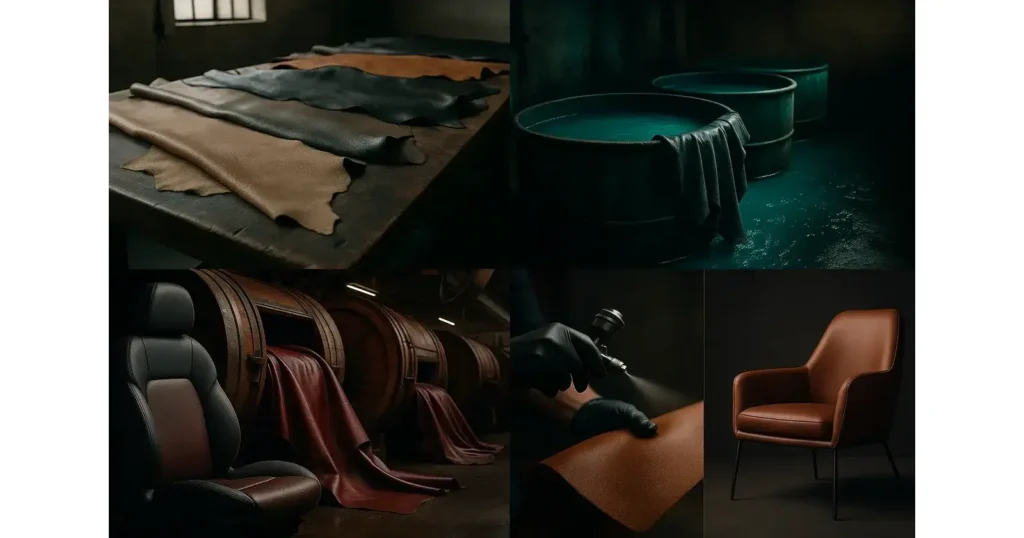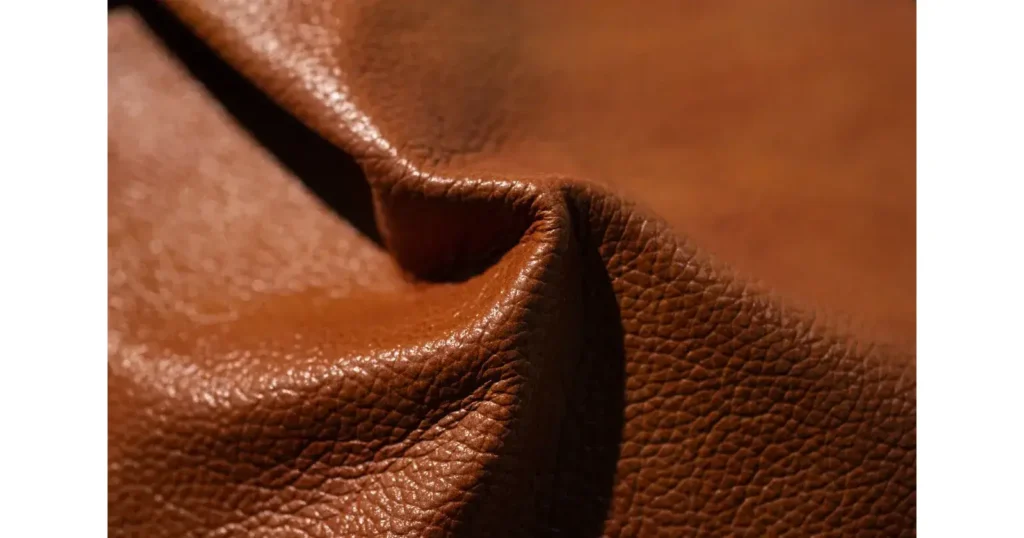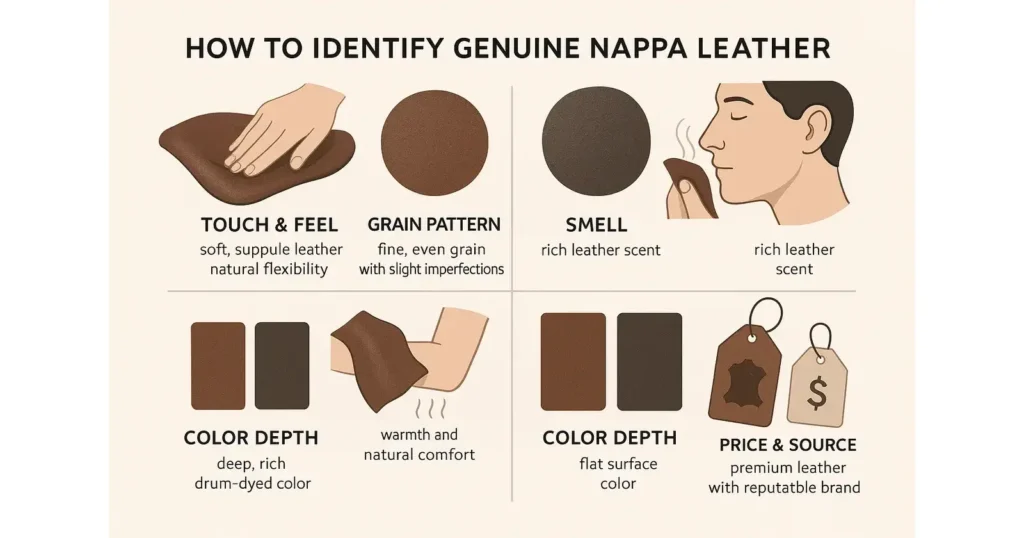Soft as a whisper, strong as time itself—Nappa leather is in a league of its own. Surprisingly, less than 10% of the world’s leather ever earns the title “Nappa,” a mark reserved only for hides that embody unmatched softness and exceptional quality. Coveted by luxury fashion houses, fine furniture makers, and even high-end car designers, this leather doesn’t just look beautiful—it feels extraordinary. With its buttery-smooth touch, breathable nature, and lasting durability, Nappa transforms everyday items into timeless statements of elegance and comfort.
In this article, we will uncover everything you need to know about Nappa leather.
Nappa leather, sometimes spelled Napa leather, is a premium, soft, and supple type of real leather prized for its luxurious feel and smooth texture. First developed in Napa, California, this fine-grain material is usually made from high-quality hides such as lamb, calf, or kid goat. Known for its breathability, flexibility, and rich color depth, Nappa leather is often used in luxury car interiors, handbags, shoes, and high-end furniture. Unlike standard or genuine leather, it undergoes a special tanning and dyeing process that enhances softness while maintaining durability—making it a favorite choice for both fashion lovers and leather enthusiasts.
The term Nappa refers more to a leather’s quality and finish than to the animal it comes from. While you’ll often see it spelled Napa leather, both refer to the same material. The name comes from Napa, California, where tanner Emanuel Manasse first developed this exceptionally soft, full-grain leather in the late 19th century.
Unlike terms like full-grain leather or top-grain leather, “Nappa” isn’t a strict industry classification. Instead, it describes leather that has a fine grain, supple feel, and is often chrome-tanned for flexibility. This can be made from lamb, calf, goat, or even high-quality cowhide.
In modern markets, Nappa leather is a popular choice for premium applications like luxury car seats, handbags, shoes, and furniture upholstery. The combination of smooth texture, breathability, and durability makes it stand out from standard leathers.
Nappa leather has its roots in late 19th-century Napa, California. In 1875, Emanuel Manasse, a German-born tanner working for the Sawyer Tanning Company, developed a method to produce an exceptionally soft and smooth leather using high-quality hides. This innovation led to what we now call Nappa leather (or Napa leather).
Originally, Nappa leather was made from full-grain lamb or kid goat hides, prized for their fine grain and natural softness. Over time, the technique expanded to include calf and select cowhides, always focusing on hides with minimal imperfections. The key difference was the gentle tanning and dyeing process—often chrome tanning—that kept the leather supple, breathable, and rich in color.
The name “Nappa” became synonymous with luxury and comfort, especially in fashion and automotive industries. Early luxury handbags, gloves, and shoes used Nappa for its drape and polished appearance. Later, high-end carmakers began offering Nappa leather seats, valued for their comfort and durability.
Nappa leather can be made from several types of animal hides, but what matters most is the quality of the hide and the tanning process used. Traditionally, full-grain lamb and kid goat hides were the preferred choice because of their naturally fine grain and exceptional softness. These hides require minimal surface correction, allowing the leather to retain its smooth texture and flexibility.
Over time, calfskin and premium cowhide also became popular for Nappa production, especially in applications like Nappa leather seats and furniture upholstery where durability is essential. In the automotive industry, European cowhides are often favored for their size, consistency, and strength.
Hide selection starts with inspecting for blemishes, scars, or imperfections that could affect the final appearance. The best hides have an even grain pattern and supple feel before tanning begins.
It’s worth noting that the term “Nappa” doesn’t refer to a specific animal—it describes the finish and feel of the leather. Whether it comes from lamb, calf, or cow, genuine Nappa leather will always be soft, breathable, and richly colored, thanks to careful sourcing and specialized tanning. This attention to hide quality is what sets Nappa leather apart from more common leathers on the market.

The process of making Nappa leather focuses on preserving softness while enhancing durability. It begins with carefully selected hides—often lamb, calf, goat, or premium cowhide. Once chosen, the hides go through cleaning and preparation to remove any debris, hair, or natural oils.
Tanning is the next step, and chrome tanning is the most common method for Nappa leather. This process keeps the leather supple, flexible, and resistant to heat and moisture. In some cases, vegetable tanning or alum tanning is used for eco-friendly or specialty finishes.
After tanning, the hides are drum dyed using water-soluble dyes. This technique allows color to penetrate deeply, creating rich, fade-resistant shades. Finishing touches may include light pigmentation, semi-aniline coatings, or protective layers like wax or polyurethane to improve wear resistance.
Throughout the process, the goal is to maintain the leather’s fine grain and smooth texture. Minimal surface correction ensures the natural beauty of the hide remains visible.
By combining careful hide selection, expert tanning, and skilled finishing, Nappa leather achieves its signature softness, breathability, and luxurious feel—qualities that make it a favorite for luxury car seats, handbags, shoes, and high-end furniture upholstery.
Nappa leather is valued for its combination of softness, durability, and natural beauty. One of its most notable traits is its smooth, fine grain, which feels supple to the touch and drapes easily without stiffness. This makes it ideal for products that require comfort and flexibility, like Nappa leather seats, jackets, and handbags.
Because it’s usually full-grain or top-grain leather, Nappa retains the strongest natural fibers in the hide, giving it both strength and breathability. The leather adapts to body temperature, making it comfortable for year-round use—whether in clothing or car interiors.
Its color depth is another hallmark. Thanks to drum dyeing, shades are rich, even, and resistant to fading over time. Properly finished Nappa leather is also more resistant to light scratches, moisture, and stains than many other leathers.
Breathability ensures that Nappa doesn’t trap heat, while its flexibility allows it to keep its shape without cracking. Even with these qualities, it remains lightweight, making it a practical choice for everyday luxury.
These combined characteristics—softness, fine grain, durability, and color richness—are what set genuine Nappa leather apart from standard leathers, ensuring it offers both comfort and elegance in any application.
Nappa leather comes in different types and grades, each offering unique qualities depending on the hide used and the finishing process.
Full-grain Nappa leather is the highest quality, made from the top layer of the hide with no surface corrections. It retains the natural grain, making it the most durable and breathable option while offering a rich, luxurious feel.
Top-grain Nappa leather is slightly refined, with minimal surface buffing to remove imperfections. It still provides softness and strength but has a more uniform appearance.
Corrected-grain Nappa leather undergoes more surface treatment, often including embossing or light coating, to create a consistent grain pattern. While slightly less breathable, it can be more resistant to stains and wear.
You may also find nubuck Nappa leather, which has a lightly sanded surface for a velvet-like texture, and finishes like aniline, semi-aniline, or pigmented Nappa, which vary in color richness and protection.

The grade and type you choose often depend on the intended use. Full-grain is ideal for high-end furniture and luxury bags, while corrected-grain works well for automotive interiors that require extra resilience without sacrificing the signature softness of Nappa leather.
Nappa leather stands out from many other leather types because of its unique blend of softness, breathability, and refined appearance. Compared to full-grain leather, Nappa often feels smoother and more supple, though both are made from the top layer of the hide. Full-grain tends to be more rugged, while Nappa leans toward luxury and comfort.
When compared to top-grain leather, Nappa usually retains more natural softness due to less surface treatment, making it ideal for premium goods like Nappa leather seats or handbags.
Against genuine leather, Nappa is in a completely different class. Genuine leather is made from lower hide layers and is often heavily processed, resulting in a stiffer, less breathable material.
Versus bonded leather or PU leather (faux leather), Nappa wins in durability, comfort, and appearance. While synthetics can be more affordable and easier to maintain, they lack the natural feel and breathability of real Nappa.
Even when compared to pebbled leather, Nappa’s smooth grain gives it a sleeker, more elegant look. Each type has its uses, but Nappa’s combination of quality and luxury makes it a preferred choice for those who want softness without sacrificing strength.
Nappa leather’s versatility makes it a favorite across fashion, automotive, and interior design industries. Its soft, fine-grain texture and durability mean it’s perfect for luxury goods that require both comfort and style.
In fashion, Nappa leather is widely used for handbags, wallets, belts, gloves, and jackets. The smooth finish and flexibility make it comfortable to wear and easy to style. High-end footwear brands also use Nappa for premium shoes and boots, where comfort and elegance are equally important.
In the automotive industry, Nappa leather seats are a popular upgrade in luxury vehicles. They not only feel plush but also stay breathable, making long drives more comfortable. Many premium car brands offer Nappa as part of their top interior packages.
For home interiors, Nappa is used in high-end sofas, armchairs, and office chairs. Its softness and refined appearance add a touch of luxury to living spaces while maintaining practicality for everyday use.
Pros:
Cons:

Spotting authentic Nappa leather can be tricky, especially since the term isn’t strictly regulated. However, there are a few clear signs to look for.
Genuine Nappa leather has a buttery-soft, supple texture. It should feel smooth without being slippery or overly coated. Pressing it lightly should reveal a natural flexibility.
Look for a fine, even grain with minimal imperfections. Full-grain Nappa will show slight natural markings, while overly perfect patterns may indicate synthetic or corrected leather.
Real Nappa has a distinct, rich leather scent that synthetic materials cannot replicate.
Hold it against your skin—authentic Nappa will feel warm and breathable, not plasticky.
Drum-dyed Nappa has rich, deep colors that won’t simply sit on the surface.
Genuine Nappa is a premium material, so extremely low prices can be a red flag. Always buy from reputable brands or sellers.

Nappa leather is luxurious, but it needs proper care to keep its softness, color, and durability intact. Since it’s a fine-grain leather, harsh cleaning methods or strong chemicals can cause damage.
Regular Care:
Dust the surface weekly with a soft, dry cloth. For deeper cleaning, use a slightly damp microfiber cloth and gently wipe the leather. Avoid soaking it in water.
Cleaning:
Use a leather cleaner specifically formulated for Nappa leather. Apply a small amount to a clean cloth, test on a hidden area first, then wipe gently in circular motions. Never use abrasive sponges, alcohol, or household detergents.
Conditioning:
Every 3–6 months, apply a high-quality leather conditioner to keep the leather supple and prevent cracking. Conditioning also helps maintain the rich color and smooth texture.
Protection:
Keep Nappa leather away from direct sunlight and heat sources to avoid fading and drying. In cars, use sunshades; for furniture, place it away from radiators or windows.
With consistent cleaning, conditioning, and protection, Nappa leather products can maintain their luxury feel and appearance for many years—making them worth the investment.
Nappa leather is considered a premium material, and its price reflects the quality, craftsmanship, and luxurious feel it offers. The cost can vary depending on the type of hide used, the tanning process, and the product category. For example, full-grain Nappa leather jackets or handbags are usually more expensive than items made from corrected-grain Nappa, while Nappa leather seats in cars are often part of high-end upgrade packages.
In terms of value, Nappa leather’s softness, breathability, and durability make it worth the investment—especially if you want a product that combines comfort with a timeless, upscale look. Properly maintained, it can last for many years without losing its appeal.
Buying Advice:
When it comes to Nappa leather, sustainability and ethical sourcing are becoming increasingly important for consumers. Traditional leather production often raises concerns about environmental impact, but many manufacturers are now adopting more responsible practices.
Eco-Friendly Tanning:
Some brands use vegetable tanning or chrome-free processes to reduce harmful chemical waste. These methods are safer for the environment and often produce biodegradable leather.
Ethical Hide Sourcing:
High-quality Nappa leather is typically made from hides that are byproducts of the meat industry, meaning no animals are raised solely for their skins. Ethical sourcing also ensures compliance with animal welfare standards.
Traceability:
Premium leather suppliers are now offering full traceability, allowing customers to know exactly where the hides come from and how they were processed.
Sustainable Alternatives:
Some companies are experimenting with plant-based or recycled materials that mimic Nappa leather’s softness, aiming to reduce reliance on animal hides while maintaining luxury appeal.
Nappa leather is a popular term in fashion, automotive, and upholstery markets, it’s surrounded by several myths that can confuse buyers. Let’s clear them up.
Myth 1: Nappa leather is a specific animal leather.
False. Nappa refers to a type of finish and softness, not the animal source. It can be made from calf, lamb, or even goat hide.
Myth 2: All Nappa leather is full-grain.
Not always. While many high-quality versions are full-grain, some are top-grain or even corrected-grain. The softness doesn’t always indicate the grain type.
Myth 3: It’s maintenance-free.
Wrong. Even though Nappa leather is durable, it still requires cleaning and conditioning to preserve its softness, color, and strength.
Myth 4: If it’s labeled “Nappa,” it’s always premium quality.
Not necessarily. The term isn’t strictly regulated, so lower-grade leathers can still be marketed as Nappa. That’s why it’s important to inspect the grain, texture, and source.
For those who appreciate the finer details, Nappa leather offers impressive technical characteristics that set it apart from standard leather types.
Grain & Thickness:
Nappa leather typically has a fine, smooth grain with a thickness ranging from 0.9mm to 1.2mm. This balance gives it strength while keeping it lightweight and flexible.
Tanning Process:
Most high-end Nappa is drum-dyed using aniline or semi-aniline finishes, which allow the dye to penetrate deep into the hide. This results in rich, uniform color while maintaining natural breathability.
Softness Rating:
On a softness scale, Nappa scores highly due to minimal surface corrections and the use of premium hides like lamb or calf.
Tensile Strength:
Despite its softness, Nappa leather boasts excellent tensile strength, meaning it resists stretching and tearing—ideal for Nappa leather seats, handbags, and gloves.
Breathability & Comfort:
The open pores of genuine Nappa allow air to circulate, reducing heat buildup and increasing comfort for wearables and upholstery.
Nappa leather stands out as one of the most luxurious and comfortable types of leather available. Known for its buttery-soft texture, breathability, and refined appearance, it has become a favorite in everything from high-end car interiors to designer handbags and premium jackets. While it may come at a higher price than standard leather, its combination of comfort and durability makes it a worthwhile investment for those who value quality.
Choosing genuine Nappa leather means paying attention to details—examining the grain, texture, and source to ensure authenticity. Caring for it with proper cleaning and conditioning will help preserve its rich look and soft feel for many years.
As the demand for sustainability and ethical sourcing grows, many brands are now producing Nappa leather with eco-friendly tanning methods and transparent supply chains, making it possible to enjoy luxury without compromising values.
If you’re considering Nappa leather products, always check for authenticity and proper care. Explore our buying guides for leather jackets, handbags, and car interiors.
IsItRealLeather began with one goal: to defend and promote authentic leather in a world full of cheap substitutes. We’re not a brand or manufacturer—we are a community-driven resource backed by writers, leather crafters, and passionate consumers from around the world.
Sign up, you’ll love hearing from us. We promise!